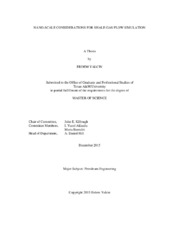| dc.description.abstract | This study basically focuses on numerical simulation of shale gas flow. To be able to capture the complex nature of shale gas reservoirs, different storage and flow mechanisms must be taken into consideration.
Shale reservoir medium consists of organic matter (kerogen), inorganic matter, natural fractures, and hydraulic fractures. In this medium, Darcy flow is not fully capable of modeling shale gas flow since there is different flow mechanisms due to complex porosity system. In addition, Fickian diffusion and flow from matrix to fractures must be considered. For this purpose, the multiple porosity model is used. To be able to keep the resolution of the micromodel on the reservoir scale simulation, the idea of dynamic apparent permeability is followed.
Storage mechanisms of shale gas is also as complex as flow mechanisms. Gas is not only stored as free fluid in pores and fractures, but also as adsorbed phase at the surface of organic matter. However, fluid properties of free gas in nano-scale pores are different than their original values. Also adsorbed phase occupies considerable amount of pore volume which causes reduction in free gas volume. As pore pressure decreases throughout the reservoir life, desorbed gas will be produced with free gas. Thus better understanding of this adsorbed gas behavior within organic matter is the key for accurate modeling of desorption and total gas production.
The proposed workflow is first integrating desorption to the reservoir model by commercial simulator feature. Second, integrating diffusion using the multiple porosity model and application of dynamic apparent permeability to upscale the model. Third, different fluid properties are introduced to simulator by defining another PVT region. Finally, occupied pore space by adsorbed phase is introduced by modifying Langmuir parameters.
Results are discussed by comparing different cases with cumulative gas production and average reservoir pressure. Significant difference of the models with and without integrating relevant model and properties shows the importance of the nanoscale considerations and their effect on ultimate recovery calculations. Decreasing pore size has a strong effect on gas formation volume factor and viscosity. It causes a decrease on cumulative gas production and average reservoir pressure.
Nano-scale effects have a huge impact on both cumulative gas production and reservoir pressure. As a result, accurate modeling and reducing uncertainity require special attention on desorption, diffusion, pore size effect, and pore volume correction. | en |


